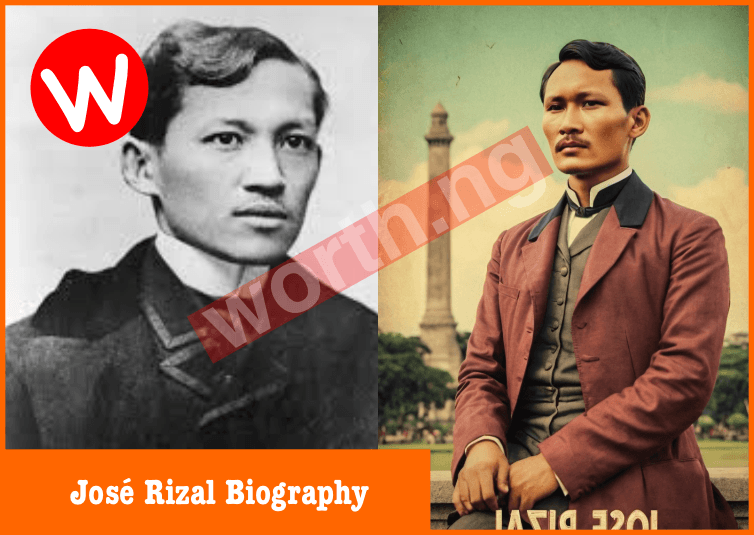
José Rizal Biography – Learn about José Rizal, the Philippine national hero, including his full name, wife, age, death, artistic talents, career achievements, and his lasting impact on the country’s history.
José Rizal is one of the most celebrated figures in Philippine history, revered as a national hero for his contributions to the country’s independence movement. Born into a middle-class family, Rizal demonstrated exceptional intellect and talent from a young age, excelling in multiple fields such as literature, medicine, and the arts. His life, works, and tragic death have left an indelible mark on the Philippines, inspiring generations to fight for freedom and justice.
This blog post delves into José Rizal’s life, including his background, personal relationships, artistic pursuits, and his monumental contributions to Philippine society.
José Rizal Biography: Personal Information
| Field | Details |
|---|---|
| Full Name | José Protasio Rizal Mercado y Alonzo Realonda |
| Birthdate | June 19, 1861 |
| Age at Death | 35 years old |
| Death | December 30, 1896, Bagumbayan, Manila |
| Wife/Partner | Josephine Bracken |
| Famous Works | “Noli Me Tangere,” “El Filibusterismo” |
| Artistic Pursuits | Drawing, sculpture, and painting |
| Career | Physician, novelist, activist, and polyglot |
| Legacy | National hero of the Philippines |
Key Takeaways
- Full Name: José Protasio Rizal Mercado y Alonzo Realonda.
- Birthdate: June 19, 1861.
- Wife: Josephine Bracken (common-law wife).
- Age at Death: 35 years old.
- Death: Executed on December 30, 1896, in Bagumbayan (now Rizal Park), Manila.
- Artistic Talents: Known for his drawings, sculptures, and literary works.
- Legacy: National hero of the Philippines and author of “Noli Me Tangere” and “El Filibusterismo.”
Background and Early Life
José Rizal was born on June 19, 1861, in Calamba, Laguna, to Francisco Mercado and Teodora Alonso. He was the seventh of eleven children in a family that valued education and cultural enrichment. From an early age, Rizal displayed remarkable intelligence and a deep love for learning.
He attended the Ateneo Municipal de Manila and later studied medicine at the University of Santo Tomas. His thirst for knowledge led him to Europe, where he completed his medical studies at the Universidad Central de Madrid.
Personal Life and Relationship
José Rizal’s personal life is as intriguing as his professional achievements. He had romantic relationships with several women, but his most significant partner was Josephine Bracken, an Irish woman who became his common-law wife during his exile in Dapitan.
The couple’s relationship was filled with challenges, including the loss of their only child, a son who died during birth. Despite these hardships, Bracken stood by Rizal’s side until his execution.
Career Achievements
Literary Works
Rizal is best known for his novels “Noli Me Tangere” and “El Filibusterismo,” which exposed the social injustices and corruption under Spanish colonial rule. These works played a pivotal role in awakening Filipino nationalism and inspiring the revolutionary movement.
As a Physician
Rizal was also a skilled ophthalmologist, performing surgeries to restore vision. His medical practice in Dapitan demonstrated his dedication to serving others, particularly the underprivileged.
As an Artist
Rizal was a talented artist, known for his intricate drawings and sculptures. His artistic works often reflected his patriotism and deep connection to Filipino culture.
As a Polyglot
Fluent in more than 20 languages, Rizal’s linguistic abilities allowed him to connect with people from various cultures and share his ideals on a global scale.
Death and Legacy
On December 30, 1896, Rizal was executed by a firing squad in Bagumbayan, Manila, for his alleged involvement in the Philippine Revolution. His death cemented his status as a martyr and a symbol of the country’s fight for freedom.
Today, José Rizal is honored as the national hero of the Philippines. His works and sacrifices continue to inspire Filipinos to value independence, education, and civic responsibility.
Artistic Talents: Drawing and Sculpture
Rizal’s artistic pursuits were not merely hobbies but a reflection of his deep love for his country and people. He created intricate sketches and sculptures that captured Filipino life and culture.
One of his notable drawings depicts his dream of a free and prosperous Philippines, emphasizing his vision for the nation’s future.
Key Takeaways from José Rizal’s Life
- Rizal’s unwavering commitment to education and justice serves as an inspiration to all.
- His novels remain essential reading for understanding Philippine history and identity.
- Despite his tragic death, Rizal’s legacy lives on as a beacon of hope and resilience.
Conclusion
José Rizal’s life is a testament to the power of intellect, creativity, and courage in the face of oppression. As a writer, doctor, artist, and patriot, he dedicated his life to advocating for the rights and dignity of his fellow Filipinos.
Through his sacrifices and timeless works, Rizal continues to inspire generations to strive for a better, freer, and more equitable world.
FAQs About José Rizal Biography
1. What is José Rizal’s full name?
José Rizal’s full name is José Protasio Rizal Mercado y Alonzo Realonda.
2. Did José Rizal have a wife?
Rizal had a common-law wife, Josephine Bracken, who supported him during his exile in Dapitan.
3. What are José Rizal’s most famous works?
Rizal’s most famous works are the novels “Noli Me Tangere” and “El Filibusterismo.”
4. How old was José Rizal when he died?
Rizal was 35 years old when he was executed on December 30, 1896.
5. Why is José Rizal considered a national hero?
Rizal is considered a national hero for his contributions to Philippine independence, particularly through his writings and peaceful advocacy for reform.





